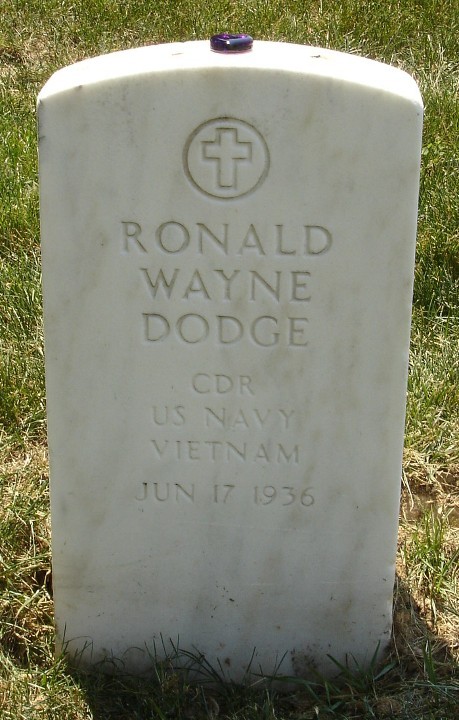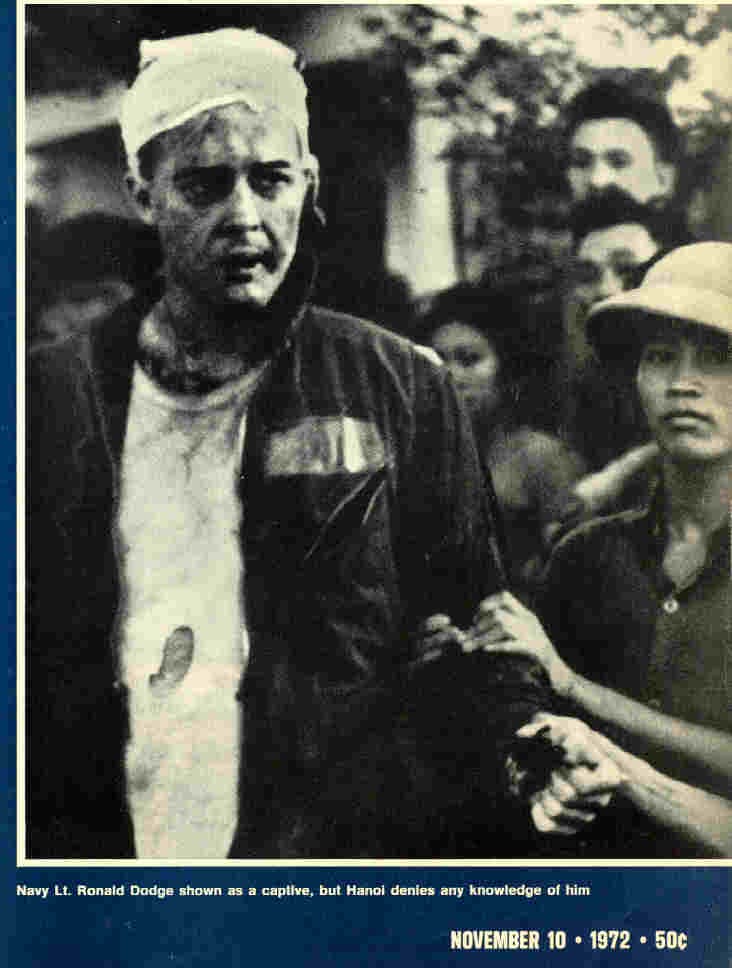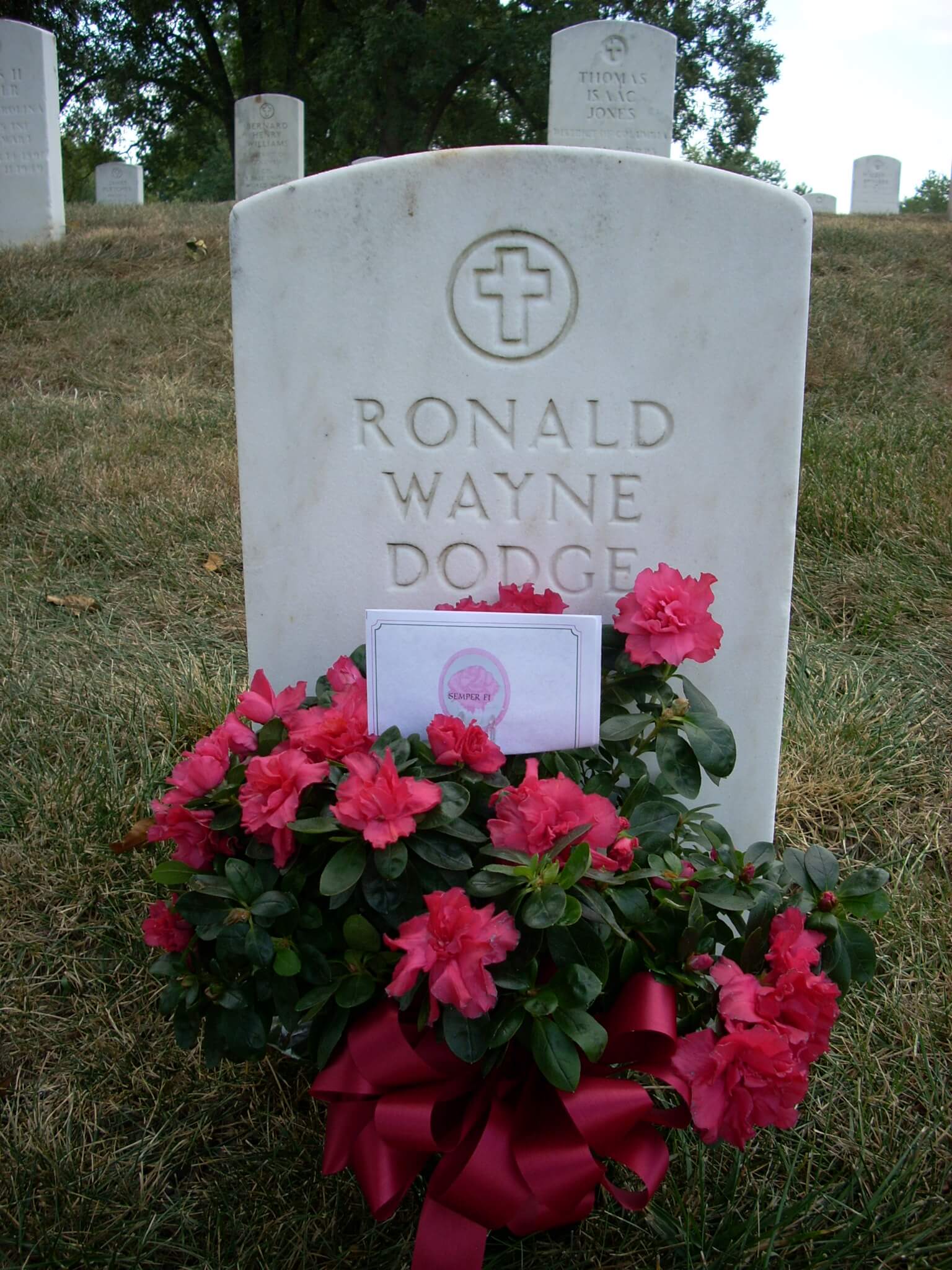Fourteen years after they last saw him, most members of the family of Navy Commander Ronald W. Dodge, an Olympia man shot down over North Vietnam in 1967, will be in attendance for his funeral. Services will be Friday at Arlington National Cemetery near Washington, D. C.
On Tuesday, the Defense Department identified Dodge as one of three U. S. fliers whose remains recently were received by the government from Vietnam.
All three had been declared dead by the armed services after boards investigated available information of their fate.
Dodge’s mother and stepfather, Mr. and Mrs. James King of Olympia said yesterday that they would be in Arlington along with Dodge’s sister, Mrs. Tod (Judy) Davidson, also of Olympia.
Dodge’s widow, Janice, will be joined in Washington by the dead flier’s two children, Brad 17, and Wendy, 20. Mrs. Dodge, long active in the POW-MIA recovery effort was in Washington Tuesday when it was announced that one of the bodies returned by North Vietnam was that of her husband.
Brad, a San Diego high school student, and Wendy, who took final exams Tuesday at San Diego State University, where she is a business major, had arranged to fly together to Washington for their father’s funeral.
The Dodges moved to San Diego in 1966 when Commander Dodge was transferred to Miramar Naval Air Station.
The remains of Dodge and two other Americans were turned over to a U. S. delegation in Hanoi 7 July during a visit by the U. S. team in connection with periodic efforts to stimulate Vietnamese searches for the bodies of Americans unaccounted for since the end of the war in Southeast Asia more than eight years ago.
Identification followed examination at a military laboratory in Hawaii.
Lieutenant Colonel Joe Harvey, who headed the team that visited Hanoi, told reporters last week that “some personal effects” apparently belonging to the dead airmen had been provided along with the remains. The Associated Press (Tacoma News Tribune, Tacoma WA, 22 Jul 1981).
DODGE, RONALD WAYNE
- Remains Returned July 8, 1981
- Name: Ronald Wayne Dodge
- Rank/Branch: O3/US Navy
- Unit:
- Date of Birth: 17 June 1936
- Home City of Record: San Diego, California
- Date of Loss: 17 May 1967
- Country of Loss: North Vietnam
- Loss Coordinates: 184759N 1052358E (WF419795)
- Status (in 1973): Prisoner of War
- Category: 1
- Acft/Vehicle/Ground: F8E
Other Personnel in Incident: (none missing)
Source: Compiled by Homecoming II Project 01 April 1991 from one or more of the following: raw data from U.S. Government agency sources, correspondence with POW/MIA families, published sources, interviews. Updated by the P.O.W. NETWORK.
REMARKS:
The Vought F8 “Crusader” saw action early in U.S. involvement in Southeast Asia. Its fighter models participated both in the first Gulf of Tonkin reprisal in August 1964 and in the myriad attacks against North Vietnam during Operation Rolling Thunder. The Crusader was used exclusively by the Navy and Marine air wings (although there is one U.S. Air Force pilot reported shot down on an F8) and represented half or more of the carrier fighters in the Gulf of Tonkin during the first four years of the war. The aircraft was credited with nearly 53% of MiG kills in Vietnam.
The most frequently used fighter versions of the Crusader in Vietnam were the C, D, and E models although the H and J were also used. The Charlie carried only Sidewinders on fuselage racks, and were assigned such missions as CAP (Combat Air Patrol), flying at higher altitudes. The Echo model had a heavier reinforced wing able to carry extra Sidewinders or bombs, and were used to attack ground targets, giving it increased vulnerability. The Echo version launched with less fuel, to accommodate the larger bomb store, and frequently arrived back at ship low on fuel. The RF models were equipped for photo reconnaissance.
The combat attrition rate of the Crusader was comparable to similar fighters. Between 1964 to 1972, eighty-three Crusaders were either lost or destroyed by enemy fire. Another 109 required major rebuilding. 145 Crusader pilots were recovered; 57 were not. Twenty of these pilots were captured and released. The other 43 remained missing at the end of the war.
Lieutenant Ronald W. Dodge was the pilot of an F8E assigned a combat mission over North Vietnam on May 17, 1967. When Dodge was about 20 miles northwest of the city of Vinh in Nghe An Province, North Vietnam, his aircraft was shot
down. Safely on the ground, Dodge talked with his wingman on the radio and waved him off. He discussed moving up the hill. During this period, he made three radio transmissions, one of them reporting being surrounded by North Vietnamese forces and saying, “I’m breaking up my radio.” One pilot, Mdcleary, saw Dodge being captured.
For the next years, Dodge’s wife, Jan, was tortured by photos which appeared on the cover of the September 9, 1967, Paris Match, and in a propaganda film made by East Germany called, “Pilots in Pajamas.” In the Paris Match photo,
Dodge’s head was bandaged, but in the German film, he was walking on his own power between guards. Jan Dodge had little idea of the torture that Ron Dodge was enduring in the hands of the Vietnamese. It is the general feeling among returned POWs that Ron Dodge was tortured to the point of death.
When 591 American prisoners were released in 1973, Ron Dodge was not among them. The Vietnamese denied any knowledge of him, in spite of the widely-published photographs of Ron Dodge in captivity.
Then, in 1981, the Vietnamese “discovered” and returned the remains of Ron Dodge to U.S. control.
It is comforting for each family to receive, after years and years of grief and wonder, the remains of their loved ones. However, it is tragic to receive the remains of persons such as Ron Dodge and others who were known to have been POWs when the Vietnamese continually denied knowledge of them. The U.S. points to such returns of remains as “progress” on the POW/MIA issue, when actually, we are subjugating our honor to our long-ago enemy, and gratefully accepting the “gift” of remains which should have been returned decades ago. We have allowed the Vietnamese to use the remains as political leverage.
Since the war ended, over 10,000 reports relating to Americans missing, prisoner or unaccounted for in Southeast Asia have been received by the U.S. Government. Many authorities who have examined this largely classified information are convinced that hundreds of Americans are still held captive today. In light of this information, it is doubly questionable that the U.S. is pursuing an honorable solution of the POW/MIA issue.
NAME: DODGE, Ronald W., LT., USN
OFFICIAL STATUS: CAPTURED
CASE SUMMARY: SEE ATTACHED
RATIONALE FOR SELECTION:
After landing, Lt. Dodge established radio contact with his wingman. He stated he was surrounded by enemy troops. North Vietnamese news media described the downing of Lieutenant Dodge’s aircraft and his immediate capture. There is no evidence to indicate his death.
On 17 May 1967 Lieuenant Ronald W. Dodge was the pilot of an F8E aircraft, (BUNO #149138), as lead in a flight of two on a flak-suppression mission over North Vietnam. For no apparent reason, Lieutenant Dodge ceased a radio transmission and his aircraft made a descending nose-down maneuver. He ejected from his aircraft at 7,500 feet. (The aircraft crashed at grid coordinates (GC) WF 419 795.) Lieutenant Dodge’s parachute was seen in the vicinity of (GC) WF 421 789, near the aircraft wreckage. He established radio communication with his wingman and reported that he was surrounded by enemy troops. He said that he was moving up the hill, as he was surrounded and was going to break up his radio. LT Dodge was never seen on the ground, but the wingman did see a group of people gathered on a hillside near the crash site. Search and rescue efforts were called off on the assumption that Lieutenant Dodge had been captured.
In the 18 May 1967 edition of the Nhan Dan newspaper, an article described the downing of Lieutenant Dodge’s aircraft, and stated that the pilot had been captured. A 17 May 1967 Radio Hanoi broadcast also described the downing of Lieutenant Dodge’s aircraft, and stated that he was captured as soon as he reached the ground.
The Paris newspaper MATCH, in its 9 September 1967 edition,, showed a photo taken in North Vietnam of a captured US pilot. Lieutenant Dodge’s wife positively identified the man in the photo as her husband.
During the existence of JCRC the hostile threat in the area precluded any visits to or ground inspection of the sites involved in this case. Details of this case together with information indicating enemy knowledge of the case were turned over to the Four-Party Joint Military Team on 6 August 1973 with a request for any information which would assist in
determining status and resolution. No response was forthcoming Lieutenant Dodge’s currently carried in the status of Captured.

Michael Robert Patterson was born in Arlington and is the son of a former officer of the US Army. So it was no wonder that sooner or later his interests drew him to American history and especially to American military history. Many of his articles can be found on renowned portals like the New York Times, Washingtonpost or Wikipedia.
Reviewed by: Michael Howard


